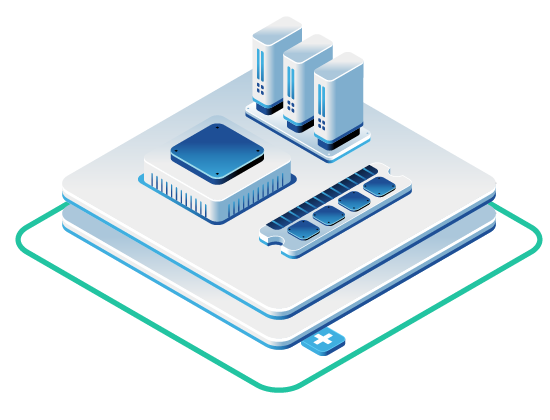
Ready to Take Control of Your Infrastructure Strategy?
See how infrastructure architectural transparency changes your team’s ability to debug, optimize, and build reliable systems.
Key Takeaways
- Infrastructure visibility is the foundation of reliability. You can’t automate what you can’t observe. True predictability means understanding how your infrastructure behaves under load—baseline latency, IO consistency, saturation points, and failure modes—not just knowing your monthly bill.
- Opaque cloud architectures waste engineering time on unsolvable problems. When noisy-neighbor interference, IO throttling, or network jitter occur in shared multi-tenant environments without root-cause access, your team spends hours troubleshooting symptoms instead of solving problems.
- Dedicated infrastructure enables debuggable systems. Single-tenant environments with full network, storage, and compute path visibility transform infrastructure from a black box into a measurable, predictable system property—allowing you to baseline performance and model behavior before incidents occur.
Cloud platforms sold “predictability” and delivered predictable bills, not predictable performance. You know exactly what your infrastructure costs each month, down to the penny. But can you predict how your storage will perform when a neighbor VM starts draining snapshots? Can you trace network jitter back to a specific oversaturated switch plane? Can you explain why your database read latency spiked from 1.2ms to 47ms without any changes to your workload?
For most teams running on shared public cloud infrastructure, the answer is no. Visibility of cost does not equal visibility of behavior. And when infrastructure behavior becomes unpredictable, reliability becomes impossible.
What Real Infrastructure Visibility Means
Infrastructure visibility isn’t about dashboards. It’s about having access to the technical properties that determine how systems actually behave: baseline latency under known load, IO consistency across storage devices, saturation points for network planes, jitter characteristics during peak traffic, replication behavior during failure scenarios, and complete network pathing from application to storage.
These are the properties that Site Reliability Engineering principles depend on. As noted in Google’s foundational work on monitoring distributed systems, “at the most basic level, monitoring allows you to gain visibility into a system, which is a core requirement for judging service health and diagnosing your service when things go wrong” (https://sre.google/workbook/monitoring/). But monitoring is only half the equation. You need the ability to inspect the underlying infrastructure layers to understand what’s actually happening.
When you lack this visibility, you can’t automate with confidence. You can’t model capacity. You can’t establish meaningful SLOs because you don’t know if performance degradation comes from your code or from invisible contention three layers below your VM. You spend engineering time fighting symptoms instead of solving problems.
Why Opaque Clouds Waste Engineering Time
The noisy-neighbor problem is well-documented but poorly understood by teams who haven’t experienced it directly. In multi-tenant cloud environments, one customer’s workload can monopolize shared resources—CPU, network bandwidth, disk IO—creating performance degradation for other tenants on the same physical hardware.
Here’s the part that breaks teams: you can observe the symptoms but can’t access the root cause. Your application logs show elevated latency. Your monitoring shows nothing wrong with your instances. Cloud support runs diagnostics and reports “system is functioning normally.” Yet your production traffic is experiencing 200ms delays that weren’t there yesterday.
Research on cloud network performance has repeatedly demonstrated this unpredictability. A comprehensive study on latency-sensitive applications in cloud environments found “significant room for improvement in isolating disk I/O between VMs” and observed network latency spikes “an order of magnitude (or more) longer” than typical LAN performance. The problem isn’t just that performance varies—it’s that the variation is invisible and therefore undebuggable.
Consider these real-world scenarios that teams encounter regularly:
- IO throttling appears without warning. Your batch job that normally completes in 14 minutes suddenly takes 50 minutes. Cloud metrics show normal disk utilization. What changed? A neighbor tenant started a massive snapshot job that saturated the shared storage controller. But you have no visibility into shared resource utilization, so you spend hours checking your code, your queries, your instance configuration—everything except the actual cause.
- Network jitter disrupts database replication. Your primary database and replica show sporadic replication lag. TCP retransmits spike but packet loss appears normal. Turns out the network plane your instances share is handling traffic bursts from a different tenant’s ML training job. Academic research has shown that in cloud data centers with multi-tenant architectures, “network jitter occurs hundreds of times daily” due to the inherent instability of large-scale shared infrastructure. You can’t fix what you can’t see.
- Support can’t help because you can’t prove the problem. When you open a ticket about performance degradation, cloud providers ask for proof: metrics showing resource exhaustion, logs demonstrating errors, reproducible test cases. But in a shared environment where you can’t run packet captures, can’t inspect hypervisor scheduling, can’t measure contention at the physical layer, you’re stuck describing symptoms. The ticket gets closed as “working as designed.”
The time lost here isn’t measured in minutes. Teams spend entire sprints trying to work around performance problems they can neither understand nor fix. Engineers who should be shipping features instead become full-time firefighters for invisible infrastructure issues.
Real-World Scenarios Where Visibility Solves the Incident
Let’s walk through how infrastructure visibility changes the debugging process.
Scenario: Network latency spike traced to saturated switch fabric.
Your API response times jump from 45ms p99 to 340ms p99 during peak traffic. Standard troubleshooting—application profiling, database query analysis, cache hit rates—shows nothing wrong. But because you have visibility into the network fabric, you can inspect per-port utilization and discover that traffic from your application tier to your database tier is traversing a switch port running at 92% utilization. The port is shared with traffic from your data pipeline that schedules heavy ETL jobs during business hours.
Solution: move the ETL traffic to a different network path or reschedule the jobs. Total time to root cause: 20 minutes instead of three days.
Scenario: Storage performance degradation from snapshot interference.
Your database read latency climbs from a baseline of 1.2ms to 8-15ms with high variance. Application-level monitoring shows increased query times but no obvious query changes. With storage-layer visibility, you identify that replication snapshots are running during peak traffic, consuming IOPS that your application workload expected to be available. The snapshots are triggered by a backup schedule that made sense when load was lower but now conflicts with production traffic patterns.
Solution: adjust snapshot timing and allocate dedicated IOPS for replication. Time saved: multiple escalations to vendor support that would have resulted in “system functioning normally” responses.
Scenario: Cascading failures from block storage throttling.
An ETL pipeline that usually processes data in parallel suddenly shows serialized behavior. Tasks that should run concurrently are queuing. With full infrastructure visibility, you trace the issue to block storage IOPS throttling that wasn’t hitting documented limits but was being soft-limited by the hypervisor due to contention on the physical storage controller. The throttling caused one task to slow down, which caused upstream tasks to retry, which amplified load, which triggered more throttling. Without visibility into the storage controller and hypervisor behavior, this failure mode would appear as “application performing poorly” rather than what it actually was: infrastructure behavior under contention.
These aren’t theoretical examples. They represent the daily reality for platform engineering teams running on infrastructure where the underlying physical and architectural layers are abstracted away. The difference between a 20-minute debugging session and a multi-day outage is often just visibility.
Predictability Equals Reliability
The connection between predictability and reliability isn’t obvious until you’ve debugged enough production incidents to see the pattern. Unreliable systems aren’t usually the result of dramatic failures. They’re the result of behavior you can’t reason about.
SRE principles teach us that reliability is built on error budgets, SLOs, and disciplined incident response. But all of these depend on a foundation: you must be able to model how your system behaves. When infrastructure performance is invisible, you can’t establish accurate SLOs because you don’t know if a given latency target is achievable. You can’t calculate error budgets because you can’t distinguish between errors caused by your code and errors caused by infrastructure contention. You can’t do effective incident response because you’re debugging with half the information.
Research on cloud performance isolation has consistently demonstrated that “predictable network bandwidth and low-jittered network latency are desirable” for reliable systems, but that achieving this requires infrastructure where “resources are provided in a timely manner”. In practical terms, this means you need to see not just what resources you have, but how those resources are being provisioned and whether contention is affecting delivery.
Visibility enables you to shift from reactive firefighting to proactive reliability engineering. When you can measure baseline performance, understand saturation points, and observe behavior under failure scenarios before they become production incidents, you can actually build reliable systems. When infrastructure is opaque, you’re always reacting—and reaction time determines MTTR, which determines availability.
OpenMetal’s Approach to Visible Infrastructure
OpenMetal’s approach to infrastructure is built around the idea that reliability begins with visibility — not just at the monitoring layer, but at the physical and architectural layers most public clouds abstract away. Because OpenMetal deployments run on dedicated hardware rather than shared multi-tenant hypervisor stacks, engineers gain full insight into the network, storage, and compute paths their workloads actually traverse. This means latency, throughput, and saturation stop being “black-box variables” and become measurable, predictable system properties.
Every Hosted Private Cloud comes with its own dedicated 20Gbps (dual 10Gbps) private network fabric where internal traffic is completely free and isolated at the VLAN level. That isolation isn’t just a billing advantage — it removes the biggest source of unpredictability in cloud networking: shared congestion. Engineers get transparent, end-to-end packet visibility, making it possible to correlate spikes in network throughput directly against storage IO, application behavior, or specific tenants.
Storage performance is similarly predictable because OpenMetal uses Ceph clusters with guaranteed device allocations — not pooled disk shared with unknown neighbors. DevOps teams can baseline read/write latency, observe placement group distribution, and understand how replication and failure domains behave in advance of an incident. Instead of reactive firefighting, teams can model expected behavior under load and plan capacity like they would in a physical data center — but with cloud automation and deployment speed.
Because the entire environment is single-tenant and API-powered, engineers can run low-level diagnostic tooling (packet captures, fio, iostat, iperf, tracing) with no restrictions. This is the opposite of hyperscale clouds, where low-level introspection is either blocked, throttled, or abstracted away. OpenMetal’s architectural transparency is what allows customers to solve problems like noisy-neighbor IO contention, unpredictable egress throttling, or network jitter — problems that would otherwise be invisible or unprovable inside a shared public cloud.
The result is not just cost predictability, but behavioral predictability. A workload that runs at 1.2ms read latency during staging will run the same in production, even during failover events, because the infrastructure is visible, dedicated, and measurable. That is the foundation for true operational reliability.
Building Reliable Systems on Visible Infrastructure
The shift from opaque to visible infrastructure changes how teams operate. Instead of spending engineering cycles working around unpredictable performance, you spend time building better systems. Instead of filing support tickets for problems you can’t prove, you use diagnostic tools to identify and resolve issues directly. Instead of treating infrastructure as an unknowable black box, you treat it as a measurable component of your architecture.
This isn’t about avoiding cloud platforms. It’s about choosing infrastructure that matches how reliability engineering actually works. When you can observe, measure, and understand the behavior of your infrastructure under real-world conditions—including failure scenarios, peak load, and resource contention—you can build systems that are genuinely reliable, not just “usually working.”
Visibility isn’t a luxury feature for teams with unlimited budgets. It’s the prerequisite for achieving stability at scale. Every hour your engineers spend debugging invisible infrastructure problems is an hour they’re not spending on improving your product, reducing technical debt, or building the observability tooling that makes your application itself more reliable.
If you’re dealing with unpredictable performance, noisy-neighbor interference, or infrastructure that behaves like a black box, it’s worth evaluating whether your current cloud architecture is actually serving your reliability goals—or just providing predictable billing.
OpenMetal offers test environments where you can experience the difference between opaque multi-tenant platforms and dedicated, inspectable infrastructure. See how architectural transparency changes your team’s ability to debug, optimize, and build reliable systems.
Frequently Asked Questions
What is infrastructure visibility and why does it matter for DevOps teams?
Infrastructure visibility means having access to the technical properties that determine how your systems behave—baseline latency, IO consistency, saturation points, network pathing, and failure modes. It matters because you can’t automate, troubleshoot, or establish meaningful SLOs without understanding how your infrastructure performs under real-world conditions. When infrastructure is opaque, teams waste time debugging symptoms rather than solving root causes.
How does the noisy-neighbor problem affect cloud performance?
The noisy-neighbor problem occurs when one tenant in a multi-tenant cloud environment monopolizes shared resources (CPU, network bandwidth, disk IO), causing performance degradation for other tenants on the same physical hardware. The challenge isn’t just the performance impact—it’s that you can observe symptoms but can’t access the root cause. Without visibility into shared resource utilization, teams spend hours troubleshooting application code when the actual problem is infrastructure contention.
What’s the difference between cost predictability and performance predictability?
Cost predictability means knowing your monthly infrastructure bill. Performance predictability means understanding how your infrastructure will behave under specific load conditions—whether storage latency will remain consistent, how network throughput scales, and what happens during failure scenarios. Some cloud platforms deliver cost predictability but not performance predictability, which is why teams experience unexpected latency spikes, IO throttling, and other issues that can’t be traced to their application code.
Why can’t standard monitoring tools solve infrastructure visibility problems?
Standard monitoring tools show you metrics about your virtual machines, containers, and applications—but they can’t show you what’s happening at the physical infrastructure layer in shared multi-tenant environments. You can see that your storage latency increased, but you can’t see that it’s because a neighbor VM is running heavy snapshot operations. You can observe network jitter but can’t inspect the shared switch fabric to identify congestion. Visibility requires access to the underlying infrastructure layers, not just application-level metrics.
How does dedicated infrastructure improve reliability compared to shared cloud platforms?
Dedicated infrastructure eliminates the noisy-neighbor problem by removing resource sharing with unknown workloads. More importantly, it provides full visibility into network, storage, and compute paths, allowing you to baseline performance, model behavior under load, and run diagnostic tools without restrictions. This architectural transparency transforms infrastructure from an unpredictable black box into a measurable system where you can establish accurate SLOs, debug issues efficiently, and build genuinely reliable systems.
Read More Blog Posts
Works Cited
- Google SRE. “Monitoring Distributed Systems.” Site Reliability Engineering, https://sre.google/workbook/monitoring/. Accessed 4 Nov. 2025.
- Huang, Wei, et al. “Empirical Evaluation of Latency-Sensitive Application Performance in the Cloud.” ResearchGate, February 2010, https://www.researchgate.net/publication/221636632_Empirical_evaluation_of_latency-sensitive_application_performance_in_the_cloud. Accessed 4 Nov. 2025.
- TechTarget. “What is Noisy Neighbor (Cloud Computing Performance)?” SearchCloudComputing, https://www.techtarget.com/searchcloudcomputing/definition/noisy-neighbor-cloud-computing-performance. Accessed 4 Nov. 2025.
- Ye, Keqiang, et al. “Network Performance Isolation for Latency-Sensitive Cloud Applications.” Science Direct, 15 June 2012, https://www.sciencedirect.com/science/article/abs/pii/S0167739X12001331. Accessed 4 Nov. 2025.
- Zhang, Yikai, et al. “Understanding the Long Tail Latency of TCP in Large-Scale Cloud Networks.” Proceedings of the 9th Asia-Pacific Workshop on Networking, ACM Digital Library, https://dl.acm.org/doi/10.1145/3735358.3735393. Accessed 4 Nov. 2025.


































